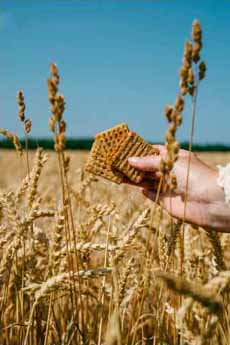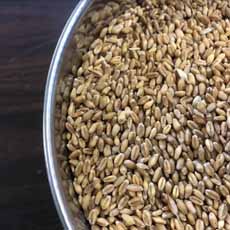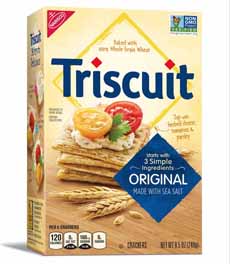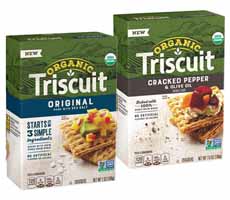TIP OF THE DAY: Travels With Triscuit…And New Ways To Enjoy Them
 [1] A field of winter wheat, right before harvesting to make Triscuits (photo courtesy Ben Hon).
|
Triscuit is one of America’s favorite snack crackers—and they’re certainly a favorite of ours!
That’s why in July, we were delighted to accompany several food lovers and writers out to the “thumb” of Michigan to meet the Triscuit team, a dedicated group of agronomy experts and product professionals who make the tasty little squares in the yellow box such an addictive treat. The first thing we were surprised to learn is that your basic Triscuit has but three (the “tri” in Triscuit) simple ingredients: wheat, canola oil, and a touch of salt. But what wheat! You can’t just toss any wheat into a Triscuit hopper and have it come out a star. Traveling to Pigeon, Michigan, we were invited to the Kretzchmer* family farm, one among hundreds of select wheat growers who comprise the Cooperative Elevator Company. These growers work hand-in-hand to seed, care for, implement, and harvest the most perfect crop possible. (The “Elevator” is what brings wheat up to be processed.) Join us on a trip to the farm, and a perspective on how a Triscuit ends up in the box on your table. Wheat has come a long way since its start in faraway lands, mainly Syria, Jordan, and Turkey, about 9,000 years ago. Triticum wheat, which is what we are most familiar with today, likely evolved from natural crossings with other ancient grains, such as spelt and durum. Today’s version is hearty enough to withstand harsh climates, and it is now the third most-grown crop in the world. The Kretzchmer family owns 900 beautiful acres of white winter wheat (photo #1), also known as “soft white wheat.” (Harder wheat varieties are more favorable for making pastas, noodles, and grinding into baking flour.) In Michigan, wheat is seeded in April and harvested in July. How do wheat growers know when it’s time to reap? By simply plucking a shaft of wheat from the ground, rolling it between their hands to get rid of the chaff, and biting into the kernel. Every drop of dewy moisture has to have evaporated, and the kernel must provide a nice crunch before the wheat is harvested by GPS-enabled combines. Each combine’s header is 40 feet wide, equipped with dozens of frighteningly long steel teeth. Once the harvest has been reaped, it is weighed and processed in a gas-heated tower that blows warm air up until the wheat is completely dried. It is then cooled. What’s left are the tiny firm, but chewy wheat berries (photo #2) —the very heart of every Triscuit. Each of the nearly 1,000 participating wheat growers in the Cooperative adheres to Triscuit’s strictly-followed promise to consumers: all wheat used is 100% whole grain, and all ingredients used are non-GMO verified. That includes all of those used in an irresistible variety of 20 flavor profiles: Original (photo #2) plus flavors as varied as Smoked Gouda; Rosemary & Olive Oil; Avocado, Cilantro & Lime, Roasted Garlic—and 15 other versatile flavors. The original Triscuits have just 120 calories per 6-cracker serving. You will not find trans fats or cholesterol in a Triscuit, and because they are made of whole grain, each cracker retains its full high fiber content (review the nutritional information on each box for exact amounts). |
|
|
In July, Triscuit introduced three flavors that are 100% USDA Certified Organic to meet the needs of consumers who solely shop for organic snack foods: Original With Sea Salt, Thin Crisps With Sea Salt, and Cracked Pepper & Olive Oil (photo #4). MORE THAN JUST A SNACK Cooking with Triscuit? Absolutely. THE NIBBLE and other farm table guests shared a magnificent dinner prepared by Chef James Rigato, whose Detroit, Michigan restaurant, Mabel Gray, recently won Eater’s “Best New Restaurant in America” and was a semi-finalist for the James Beard Award’s “Best New Restaurant.” Almost every dish was prepared using Triscuit as an ingredient, and the results were superb. Not just Triscuit as a base for canapés, but in cookies, trifle, and more. Among many choice offerings, our favorite was Chef Rigato’s Lamb Meatballs with Triscuit Crackers, which also included a spicy green tomato sugo, marinated sweet peppers, and fresh herbs, but are just as spectacular when braised in a light, fresh tomato sauce. The recipe is below. Fun Fact: The first Triscuits were made by Henry Perky, who opened his factory in Niagara Falls, New York in 1893. —Rowann Gilman |
||
|
RECIPE: LAMB MEATBALLS MADE WITH TRISCUIT This yummy recipe (photo #5) is courtesy of Chef James Rigato, Mabel Gray Restaurant, Hazel Park, Michigan. Hazel Park is located in the “thumb” of Michigan, the southeast corner of the state. The city is home to Hazel Park Raceway, currently the only track in Michigan offering live thoroughbred racing. How about dinner and a race? Ingredients For About 2 Dozen Meatballs Chef Rigato served these meatballs to us in a green tomato sauce, but he also serves them in a light tomato sauce. Use your own homemade tomato sauce recipe or your favorite prepared tomato sauce. Serve with pasta, rice or other grain, as you prefer. 1. COMBINE the crushed Triscuit crumbs with the milk in a small bowl. Let sit until crumbs have absorbed the milk. Set aside. 2. COMBINE the lamb, egg, Parmesan and Romano cheeses, and parsley in a medium bowl, combine. Use your hands to thoroughly combine the ingredients. 3. SAUTÉ the onions and garlic in a medium saucepan over medium heat. Add the wine, raise heat to high, and add the crushed red pepper flakes and dried oregano. Allow liquid to reduce until it is almost evaporated. Allow to cool. When cool enough to handle… 4. ADD the onion mixture to the meat mixture. Season to taste with salt and pepper. Add the Tabasco sauce to taste, and the Worcestershire sauce. Mix until all ingredients are thoroughly combined. 5. FORM the mixture into 1½- to 2-inch balls. Add the oil to a medium skillet and heat over medium heat. Sauté the meatballs, shaking the skillet often to sear on all sides. When browned… 6. ADD the meatballs to your preferred sauce until heated through. Adjust seasonings if necessary. |
|
|
|
________________ *No relation to the Kretschmer wheat germ family.
|
||









